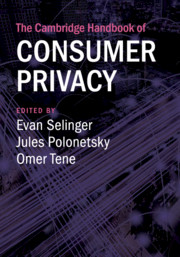Book contents
- The Cambridge Handbook of Consumer Privacy
- The Cambridge Handbook of Consumer Privacy
- Copyright page
- Contents
- Contributors
- Part I Introduction
- Part II The Pervasiveness and Value of Tracking Technologies
- Part III Ethical and Legal Reservations about Tracking Technologies
- Part IV International Perspectives
- Part V New Approaches to Improve the Status Quo
- References
Part II - The Pervasiveness and Value of Tracking Technologies
Published online by Cambridge University Press: 18 April 2018
- The Cambridge Handbook of Consumer Privacy
- The Cambridge Handbook of Consumer Privacy
- Copyright page
- Contents
- Contributors
- Part I Introduction
- Part II The Pervasiveness and Value of Tracking Technologies
- Part III Ethical and Legal Reservations about Tracking Technologies
- Part IV International Perspectives
- Part V New Approaches to Improve the Status Quo
- References
Summary

- Type
- Chapter
- Information
- The Cambridge Handbook of Consumer Privacy , pp. 23 - 148Publisher: Cambridge University PressPrint publication year: 2018



